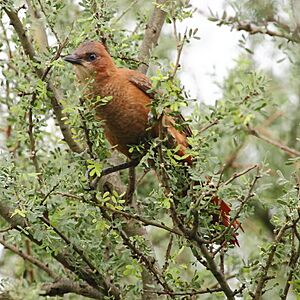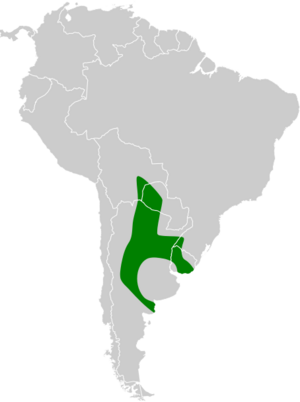Brown cacholote facts for kids
Quick facts for kids Brown cacholote |
|
|---|---|
 |
|
| At Santa Fe Province, Argentina | |
| Conservation status | |
| Scientific classification | |
| Genus: |
Pseudoseisura
|
| Species: |
lophotes
|
 |
|
The brown cacholote (Pseudoseisura lophotes) is a type of bird. It belongs to the ovenbird family called Furnariidae. You can find this bird in several South American countries. These include Argentina, Bolivia, Brazil, Paraguay, and Uruguay.
Contents
About the Brown Cacholote
Scientists group living things into different categories. This helps us understand how they are related. For the brown cacholote, some scientists believe there are two main types, called subspecies. These are P. l. lophotes and P. l. argentina. Other scientists think there is only one type. This article will talk about the two subspecies.
What Does a Brown Cacholote Look Like?
The brown cacholote is about 24 to 26 centimeters (9.4 to 10.2 inches) long. It weighs between 63 and 79 grams (2.2 to 2.8 ounces). It is one of the biggest birds in the ovenbird family. It has a noticeable crest on its head, which makes it look a bit like a jay.
Both male and female brown cacholotes look the same. Their faces are a dark reddish-brown. The top of their head and crest are a darker brown with a streaked look. Their back feathers range from bright to dull reddish-brown. Their tail is also a dark reddish-brown.
Their throat is a bright cinnamon-red. Their chest and belly are darker, with lighter tips on the feathers. Their eyes are yellow, and their beak is black with a gray base. Their legs and feet are grayish-green. Young brown cacholotes have a shorter crest and sometimes have spots on their belly. Their eyes are also greenish.
The P. l. argentina subspecies is generally darker than the other type. The front of its crest is also more reddish-brown.
Where Do Brown Cacholotes Live?
The P. l. lophotes subspecies lives in southern Bolivia and western Paraguay. The P. l. argentina subspecies is found in northern and central Argentina, southern Brazil, and Uruguay.
These birds like to live in tropical forests where leaves fall off trees. They also live at the edges of gallery forests, which are forests along rivers. You can find them in chaco woodlands and scrublands. They even live in parks and gardens in cities. They can be found from sea level up to about 900 meters (2,950 feet) high.
How Do Brown Cacholotes Behave?
Staying in One Place
Brown cacholotes do not migrate. They stay in the same area all year round.
What Do They Eat?
Brown cacholotes mainly eat arthropods, like insects and spiders. They also eat the eggs of other birds, seeds, and fruit. They usually look for food in pairs or small groups. They often search for food on the ground. They will pick up food, poke into the soil, and dig in fallen leaves. They have also been seen pecking at tree bark and leaf buds.
How Do They Raise Their Young?
Brown cacholotes lay eggs in the spring and summer, usually from September to February. They are thought to stay with the same partner for their whole lives.
Their nest is made of many sticks. It is shaped like a large ball with a tube-like entrance on the side. Inside, there is a chamber that might be lined with softer materials. The nest is built into a tree branch, usually about 4 to 6 meters (13 to 20 feet) above the ground.
A female brown cacholote lays two to four eggs. The eggs hatch after 18 to 20 days. The young birds leave the nest 18 to 23 days after hatching. Both parents take turns sitting on the eggs and feeding the baby birds.
What Sounds Do They Make?
The song of the brown cacholote is a "musical duet." It has grating notes mixed with soft, descending "tjew" sounds. Their call sounds like "krok."
Conservation Status
The IUCN (International Union for Conservation of Nature) has listed the brown cacholote as a species of "Least Concern." This means they are not currently in danger of disappearing. They live across a large area. While their exact population size is unknown, it is thought to be decreasing. However, no immediate threats have been identified. They are considered uncommon to fairly common and live in several protected areas.


